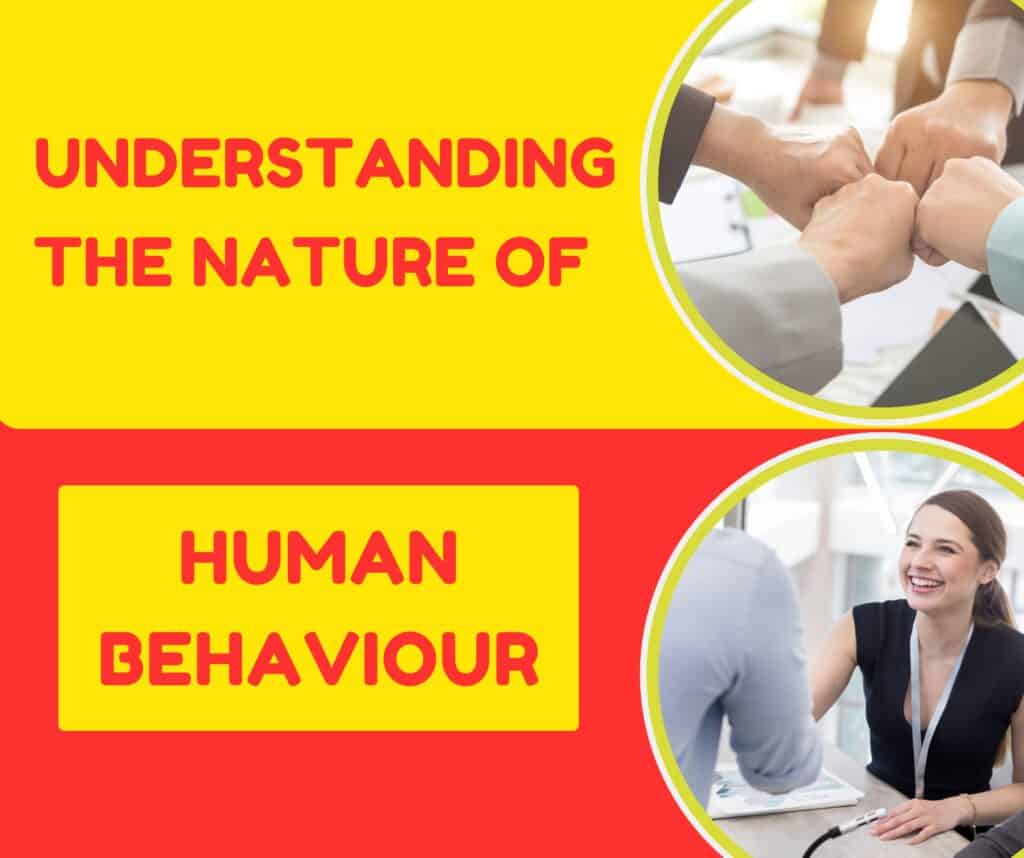Human behaviour encompasses the range of actions and mannerisms made by individuals in conjunction with their environment, which includes their thoughts, emotions, and social interactions. It is a complex and multifaceted subject that draws from various fields, including psychology, sociology, and biology. Understanding human behaviour involves examining why people act the way they do, how they respond to different stimuli, and what factors influence their actions and decisions.
A brief overview of human behaviour reveals that it is not merely a series of random actions but rather a patterned and predictable phenomenon influenced by a multitude of factors. From the simplest reflexes to the most complex decision-making processes, human behaviour is shaped by an interplay of internal and external forces. These include genetic predispositions, psychological states, social environments, and cultural norms.
The importance of understanding human behaviour extends far beyond academic interest. In everyday life, grasping the nuances of how and why people behave can lead to improved interpersonal relationships, more effective communication, and better conflict resolution. For professionals in fields such as marketing, management, healthcare, and education, insights into human behaviour are crucial for designing strategies and interventions that align with human needs and motivations.
Moreover, a deeper comprehension of human behaviour can contribute to personal growth and self-awareness. By recognizing the underlying factors that drive our own actions and reactions, individuals can make more informed choices, develop healthier habits, and foster more meaningful connections with others. Ultimately, a thorough understanding of human behaviour not only enhances our ability to navigate the world effectively but also enriches our overall quality of life.
Start your online business today. Click below!
Try Wealthy Affiliate (For Free).
What is Human Behaviour?
Definition of Human Behaviour
Human behaviour refers to the range of actions and reactions exhibited by individuals in response to various internal and external stimuli. It encompasses everything from observable actions and verbal responses to underlying mental and emotional processes. This broad definition includes both conscious and unconscious activities, as well as deliberate and automatic responses. Human behaviour can be influenced by biological factors, psychological states, social contexts, and environmental conditions.
Key Characteristics of Human Behaviour
- Complexity: Human behaviour is inherently complex and often influenced by a myriad of factors simultaneously. This complexity means that behaviour can vary widely between individuals and contexts, making it a dynamic and multifaceted subject of study.
- Variability: Behaviour can change based on different circumstances, experiences, and developmental stages. For instance, a person might act differently in a professional setting compared to a social gathering, reflecting the situational variability of behaviour.
- Adaptability: Humans have the ability to adapt their behaviour based on new information or changing environments. This adaptability is crucial for survival and personal growth, allowing individuals to respond effectively to new challenges and opportunities.
- Intentionality: Some aspects of human behaviour are deliberate and goal-oriented, driven by personal motivations, desires, and values. This intentionality is evident in decision-making processes, goal-setting, and strategic planning.
- Influence of Social and Cultural Context: Behaviour is not only a product of individual factors but also shaped by social norms, cultural values, and societal expectations. Social interactions and cultural background play a significant role in determining how individuals behave.
Examples of Different Types of Behaviour
- Reflexive Behaviour: These are automatic, involuntary responses to specific stimuli. For example, pulling your hand away from a hot surface is a reflexive action driven by the nervous system.
- Habitual Behaviour: Actions performed regularly and often subconsciously due to repetition. For instance, brushing your teeth every morning is a habitual behaviour that becomes ingrained through routine.
- Social Behaviour: Interactions with others that are influenced by social norms and relationships. Examples include cooperation, competition, and communication. Social behaviour often involves complex dynamics, such as group conformity or leadership roles.
- Emotional Behaviour: Actions driven by emotional states, such as anger, joy, or sadness. For example, crying when feeling sad or laughing when finding something amusing are emotional responses that reflect internal states.
- Cognitive Behaviour: Behaviour that stems from mental processes such as thinking, planning, and problem-solving. For instance, deciding on a career path involves cognitive behaviour as it requires evaluation, analysis, and decision-making.
- Adaptive Behaviour: Behaviour that is modified in response to new information or changing circumstances. For example, learning a new skill or altering one’s approach based on past experiences reflects adaptive behaviour.
Psychological Influences on Human Behaviour
Cognitive Processes
How Thinking Patterns Affect Behaviour
Cognitive processes refer to the mental activities involved in acquiring, processing, and storing information. These processes significantly influence human behaviour. For example, how people interpret and think about events can shape their reactions and actions. Cognitive distortions, such as overgeneralization or catastrophizing, can lead to biased or maladaptive behaviour. Conversely, positive thinking patterns and problem-solving skills can foster adaptive behaviours and resilience.
Role of Perception and Memory
Perception is the process by which individuals interpret and make sense of sensory information from their environment. It plays a crucial role in behaviour because it influences how we understand and react to various stimuli. For instance, two people might perceive the same event differently based on their past experiences, leading to different emotional and behavioural responses.
Memory also affects behaviour by influencing how we recall past experiences and apply that knowledge to current situations. Memories can guide decision-making, inform expectations, and shape future behaviour. For example, a person who has had a positive experience with a particular activity is more likely to engage in it again, while negative memories might deter them.
Emotions and Behaviour
Impact of Emotions on Decision-Making
Emotions have a profound effect on decision-making processes. Positive emotions, such as happiness or excitement, can enhance decision-making by promoting openness and creativity. Conversely, negative emotions, like fear or anger, can cloud judgment and lead to impulsive or irrational decisions. For example, stress might cause an individual to make hasty decisions without fully considering the consequences.
Emotional Regulation and Its Effects
Emotional regulation refers to the strategies individuals use to manage and respond to their emotional experiences. Effective emotional regulation can lead to more stable and adaptive behaviour, while poor emotional regulation might result in erratic or maladaptive actions. Techniques such as mindfulness, cognitive reappraisal, and relaxation exercises can help individuals manage their emotions and maintain balanced behaviour.
Disclaimer: This post contains affiliate links. If you purchase through them, I may earn a commission at no extra cost to you. These links offer access to valuable resources like training and tools for your online business.
Try Wealthy Affiliate (For Free).
Personality Traits
Influence of Personality on Behaviour
Personality traits are enduring characteristics that influence how individuals think, feel, and behave. These traits can significantly impact behaviour across various contexts. For example, individuals with high levels of extraversion may be more outgoing and sociable, while those with high levels of neuroticism may experience more frequent mood swings and anxiety.
Common Personality Theories (e.g., Big Five)
- Big Five Personality Traits: One of the most widely accepted frameworks for understanding personality is the Big Five model, which includes five major dimensions:
- Openness to Experience: Reflects curiosity, imagination, and openness to new ideas and experiences.
- Conscientiousness: Involves a high level of organization, dependability, and goal-oriented behaviour.
- Extraversion: Characterized by sociability, assertiveness, and a high level of energy.
- Agreeableness: Includes traits like compassion, cooperativeness, and a tendency to be trusting and helpful.
- Neuroticism: Reflects emotional instability, including traits such as anxiety, moodiness, and sensitivity to stress.
Biological Factors Affecting Human Behaviour
Genetics and Behaviour
Hereditary Influences on Behaviour
Genetics play a crucial role in shaping human behaviour by influencing various traits and predispositions. Hereditary factors can determine aspects such as temperament, intelligence, and susceptibility to mental health disorders. For instance, research has shown that certain traits like aggression or anxiety can have a genetic basis, as individuals with a family history of these traits are more likely to exhibit them.
Examples of Genetic Predispositions
- Personality Traits: Studies suggest that personality traits such as introversion and extraversion have a genetic component. For example, identical twins raised apart often exhibit similar personality characteristics, indicating a genetic influence.
- Mental Health Disorders: Genetic predispositions can also affect the likelihood of developing mental health conditions. For example, individuals with a family history of depression or schizophrenia are at a higher risk of developing these disorders themselves.
- Behavioral Tendencies: Genetic factors can influence behavioural tendencies such as risk-taking or impulsivity. For example, variations in certain genes have been linked to a higher propensity for addictive behaviours.
Brain Chemistry and Behaviour
Role of Neurotransmitters and Hormones
Brain chemistry, involving neurotransmitters and hormones, plays a significant role in regulating mood, emotions, and behaviour. Neurotransmitters are chemical messengers that transmit signals between nerve cells, while hormones are released into the bloodstream and affect various bodily functions, including behaviour.
- Neurotransmitters: For instance, serotonin and dopamine are neurotransmitters that influence mood and emotional regulation. Imbalances in serotonin levels are associated with depression, while dopamine is linked to pleasure and reward systems, affecting motivation and reinforcement learning.
- Hormones: Hormones such as cortisol (related to stress) and oxytocin (related to bonding and social interactions) also impact behaviour. Elevated cortisol levels can lead to anxiety and stress-related behaviours, while oxytocin can enhance social bonding and trust.
Impact of Brain Structure on Behaviour
The structure and function of the brain regions are fundamental in shaping behaviour. Different areas of the brain are responsible for various functions and behaviours:
- Prefrontal Cortex: Involved in decision-making, planning, and impulse control. Damage or dysfunction in this area can lead to difficulties with self-regulation and executive functions.
- Amygdala: Plays a key role in processing emotions, particularly fear and aggression. Hyperactivity or dysfunction in the amygdala can contribute to heightened emotional responses and anxiety disorders.
- Hippocampus: Essential for memory formation and spatial navigation. Changes in the hippocampus, such as those observed in Alzheimer’s disease, can affect memory and cognitive function.
Evolutionary Perspectives
Evolutionary Theories of Behaviour
Evolutionary psychology seeks to understand behaviour through the lens of evolution and natural selection. According to this perspective, many behavioural traits have evolved because they provided survival or reproductive advantages to our ancestors.
- Adaptive Behaviours: Behaviours that enhance an individual’s ability to survive and reproduce are more likely to be passed on through generations. For example, fear of dangerous animals may have evolved as an adaptive response to increase survival chances.
- Mate Selection: Evolutionary theories also explain mate selection behaviours, where individuals may choose partners based on traits that signal good genes or parenting potential, such as physical attractiveness or resource acquisition capabilities.
Survival and Reproductive Advantages
- Survival Instincts: Behaviours such as risk aversion and social cooperation are thought to have evolved because they increased the chances of survival in ancestral environments. For example, forming social alliances and cooperating with others could improve an individual’s access to resources and protection from threats.
- Reproductive Success: Behaviours related to reproduction, such as parenting styles and mate preferences, are influenced by evolutionary pressures. Traits that enhance reproductive success, such as nurturing behaviour or attractive physical features, are likely to be favored and perpetuated through natural selection.
Social and Environmental Influences
Socialization
How Family, Peers, and Culture Shape Behaviour
Socialization is the process through which individuals learn and internalize the norms, values, and practices of their society. It plays a crucial role in shaping behaviour from a young age and continues to influence individuals throughout their lives.
- Family: The family is often the primary agent of socialization, where individuals first encounter and learn social norms and values. Parenting styles, family dynamics, and early experiences within the family environment significantly affect behavioural development. For instance, children raised in supportive and nurturing families may develop higher self-esteem and better social skills compared to those from less supportive backgrounds.
- Peers: As individuals grow, peers become increasingly influential. Peer groups provide social interaction outside the family and contribute to the development of social skills, identity, and behaviour. Peer pressure can strongly influence behaviour, leading individuals to conform to group norms, adopt new behaviours, or make decisions based on peer expectations.
- Culture: Cultural background profoundly impacts behaviour by defining the shared beliefs, practices, and values within a group. Cultural norms dictate acceptable behaviour, social roles, and expectations. For example, cultures with a collectivist orientation may emphasize family and community over individual desires, while individualistic cultures may prioritize personal achievement and autonomy.
Ready to break free from the daily grind? Start here!
Try Wealthy Affiliate (For Free).
Impact of Social Norms and Values
Social norms are the unwritten rules and expectations for behaviour within a society. These norms guide individuals on how to behave in various situations, influencing actions and interactions. For example, social norms regarding politeness, dress codes, or professional conduct can shape how people present themselves and interact with others.
Values, which are deeply held beliefs about what is important or desirable, also play a critical role in behaviour. For instance, a society that values education highly may see higher levels of academic achievement and pursuit of learning among its members. Conversely, values related to material success or social status can drive competitive behaviours and consumerism.
Environmental Factors
Influence of Living Conditions and Surroundings
The environment in which individuals live can significantly impact their behaviour. Factors such as living conditions, access to resources, and the physical environment influence daily activities and choices.
- Living Conditions: Safe and stable living conditions contribute to overall well-being and can positively impact behaviour. In contrast, adverse conditions such as overcrowding, poor housing, or lack of basic necessities can lead to stress, health problems, and negative behaviours.
- Surroundings: The physical environment, including the presence of green spaces, recreational facilities, and urban vs. rural settings, can affect behaviour. Access to recreational opportunities may encourage physical activity and social interaction, while environmental stressors such as noise pollution or hazardous conditions can contribute to anxiety and other health issues.
Effects of Stress and Socio-Economic Status
- Stress: Chronic stress from various sources, such as work, relationships, or financial difficulties, can significantly affect behaviour. Stress can lead to behavioural changes like increased irritability, withdrawal from social activities, or unhealthy coping mechanisms such as smoking or overeating.
- Socio-Economic Status: Socio-economic status (SES) influences behaviour through access to resources, opportunities, and social support. Individuals from higher SES backgrounds may have more access to education, healthcare, and leisure activities, leading to more diverse and potentially healthier behaviours. In contrast, lower SES individuals may face barriers to accessing resources, which can impact behaviour and overall quality of life.
Situational Factors
Role of Context in Behaviour
Situational factors refer to the specific circumstances or contexts in which behaviour occurs. These factors can greatly influence how individuals act in different situations. For example, a person might behave differently in a formal work setting compared to a casual social gathering. The context can affect decisions, interactions, and overall behaviour, illustrating the adaptability and context-dependency of human actions.
Examples of Situational Influences
- Social Settings: Behaviour can change based on the social setting, such as acting more reserved in formal settings and more relaxed in informal ones. For instance, individuals might use more formal language and maintain a professional demeanor in a business meeting compared to a friendly conversation with friends.
- Group Dynamics: The presence of others can influence behaviour through phenomena such as groupthink, where individuals conform to the consensus of the group, or social facilitation, where performance is enhanced in the presence of others.
- Environmental Cues: Situational cues, such as the presence of certain objects or environmental conditions, can trigger specific behaviours. For example, seeing a “No Smoking” sign might deter individuals from smoking in that area, while the presence of a vending machine might increase the likelihood of snack consumption.
Theories and Models of Human Behaviour
Behaviourism
Key Concepts and Pioneers (e.g., B.F. Skinner)
Behaviourism is a psychological theory that focuses on the study of observable behaviour rather than internal mental states. It emphasizes the role of environmental stimuli in shaping and controlling behaviour. Key concepts in behaviourism include:
- Classical Conditioning: Developed by Ivan Pavlov, this concept involves learning through association. Pavlov’s experiments with dogs demonstrated how a neutral stimulus, when paired with an unconditioned stimulus, could eventually trigger a conditioned response. For example, a dog that hears a bell before being fed will eventually salivate at the sound of the bell alone.
- Operant Conditioning: B.F. Skinner expanded on behaviourism with operant conditioning, which involves learning through rewards and punishments. Skinner’s research showed that behaviour could be modified by reinforcing desired behaviours and punishing undesired ones. For instance, a rat in a Skinner box learns to press a lever to receive food, illustrating how positive reinforcement can shape behaviour.
Applications and Examples
- Education: Behaviourism is widely applied in educational settings, where reinforcement techniques such as praise and rewards are used to encourage desirable behaviours and academic performance.
- Behavior Modification: Behavioural techniques are used in therapy and treatment programs to modify problematic behaviours, such as addiction or phobias. Techniques include systematic desensitization and token economies.
- Training and Management: In the workplace, behaviourism principles are applied in employee training and performance management, using incentives and feedback to improve productivity and behaviour.
Humanistic Psychology
Overview of Humanistic Approaches (e.g., Carl Rogers)
Humanistic psychology emphasizes the study of the whole person and the uniqueness of individual experiences. It focuses on personal growth, self-actualization, and the inherent potential for positive change. Key figures in humanistic psychology include:
- Carl Rogers: Rogers is known for his person-centered therapy, which emphasizes the importance of providing a supportive and non-judgmental environment for individuals to explore their feelings and achieve personal growth. Rogers believed in the fundamental goodness of people and their ability to self-direct and make positive changes.
- Abraham Maslow: Another prominent humanistic psychologist, Maslow is famous for his hierarchy of needs theory, which outlines a progression of human needs from basic physiological needs to self-actualization. According to Maslow, individuals are motivated to fulfill these needs in a specific order, with self-actualization representing the highest level of personal development and fulfillment.
Focus on Personal Growth and Self-Actualization
Humanistic psychology places a strong emphasis on personal growth and self-actualization—the process of realizing one’s full potential. This approach encourages individuals to pursue personal goals, seek meaningful experiences, and develop a deeper understanding of themselves. Techniques used in humanistic therapy include:
- Unconditional Positive Regard: Providing clients with acceptance and support without judgment, which helps them feel valued and understood.
- Self-Exploration: Encouraging individuals to explore their feelings, values, and experiences to gain insight and make meaningful changes in their lives.
Cognitive Behavioural Theory
Principles of Cognitive-Behavioural Therapy (CBT)
Cognitive-Behavioural Theory (CBT) integrates cognitive and behavioural approaches to address and modify dysfunctional thinking patterns and behaviours. Key principles include:
- Cognitive Restructuring: Identifying and challenging negative or distorted thought patterns that contribute to emotional distress and maladaptive behaviours. By changing these thought patterns, individuals can alter their emotional responses and behaviours.
- Behavioural Interventions: Using techniques such as exposure therapy and behavioural activation to modify maladaptive behaviours. For example, exposure therapy gradually exposes individuals to feared situations to reduce anxiety.
- Problem-Solving Skills: Teaching individuals strategies to effectively address and manage problems, which can enhance coping skills and reduce stress.
Practical Applications in Everyday Life
- Stress Management: CBT techniques are used to manage stress by helping individuals identify and change negative thought patterns and develop effective coping strategies.
- Anxiety and Depression: CBT is widely used to treat anxiety and depression by addressing the underlying cognitive distortions and providing practical tools to manage symptoms and improve mental health.
- Self-Improvement: Individuals can apply CBT principles to set and achieve personal goals, enhance self-esteem, and develop healthier habits by changing unhelpful thought patterns and behaviours.
Conclusion
Understanding human behaviour is a complex yet fascinating endeavor that involves exploring multiple dimensions—biological, psychological, social, and environmental. Throughout this article, we’ve delved into several key aspects of human behaviour:
- Definition and Characteristics: Human behaviour encompasses a wide range of actions and reactions influenced by both internal and external factors. We’ve explored how behaviour is complex, variable, adaptable, and shaped by individual differences and social contexts.
- Psychological Influences: Cognitive processes, emotions, and personality traits play significant roles in shaping behaviour. From how our thinking patterns affect our actions to the impact of emotions and personality on our daily lives, these psychological factors are central to understanding why we behave the way we do.
- Biological Factors: Genetics, brain chemistry, and evolutionary perspectives offer insights into the biological underpinnings of behaviour. Understanding how heredity, neurotransmitters, hormones, and evolutionary pressures influence behaviour helps in appreciating the intrinsic factors that drive human actions.
- Social and Environmental Influences: Socialization through family, peers, and culture, as well as environmental factors such as living conditions and socio-economic status, profoundly impact behaviour. These influences highlight how our interactions with our surroundings and social contexts shape our actions and decisions.
- Theories and Models: Behaviourism, humanistic psychology, and cognitive-behavioural theory provide various frameworks for understanding and analyzing behaviour. Each theory offers valuable perspectives on how behaviour is learned, influenced, and modified, and they serve as practical tools for addressing different aspects of human behaviour.
Create your own success story. Click to begin
Try Wealthy Affiliate (For Free).
Importance of a Holistic Understanding of Human Behaviour
A holistic understanding of human behaviour is crucial because it recognizes the interplay between various factors—biological, psychological, social, and environmental. By considering these multiple dimensions, we can gain a more comprehensive view of why people act in certain ways and how different influences interact to shape behaviour. This integrated approach not only enhances our understanding but also improves our ability to address behavioural issues, foster personal growth, and design effective interventions.
Encouragement to Explore Further Research and Resources
The field of human behaviour is vast and continually evolving. For those interested in deepening their understanding, exploring further research and resources can be incredibly enriching. Academic journals, books, and reputable online sources provide valuable insights and the latest findings in psychology, sociology, and related fields.
Additionally, engaging with practical applications through therapy, self-help techniques, and behavioural interventions can offer hands-on experience and personal growth. Whether you are a student, a professional, or simply curious about human behaviour, continuing to explore and learn about these topics can provide a deeper appreciation of the complexities of human nature and enhance your ability to apply this knowledge in various aspects of life.
Understanding human behaviour is a journey that involves both knowledge and personal experience. We invite you to share your thoughts, experiences, or questions in the comments below. Have you noticed certain patterns in your own behaviour or in others that align with the theories and concepts discussed? Or do you have questions about how these ideas apply to real-life situations? Your insights and inquiries can spark valuable discussions and deepen our collective understanding. We look forward to hearing from you!







